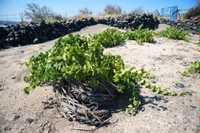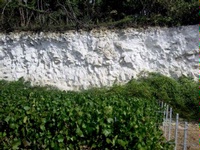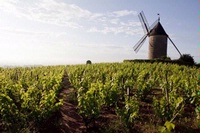|
|
 |

Grape growers know that specific sites consistently yield better or lesser quality fruit. The site differences may range from a few rows in a vineyard block to a whole winegrowing region. Piecing together the complex puzzle of factors that result in superior vineyard sites enhances one’s understanding of the true meaning of terroir. In a broad sense, geology plays a key role in determining the relative quality of a vineyard or winegrowing region. As a study of the forces that shape the earth, every specific site, vineyard or not, has a geologic story behind it.

Vineyards on Granite-Based Soils in South Africa
Many in the wine world consider geology as nearly synonymous with soil science. These, however, are very different disciplines. Geology is not just the study of rocks and their derivative soils. The study of geology encompasses the natural forces that have created the wide diversity of landforms (and undersea forms) of the earth. The geologist must also have an understanding of geologic time. As humans, we do not often think in terms of geologic time. A million years is incomprehensible to us when compared to a human lifespan, but is a basic unit of measure when considering the geologic time scale. The geologist must understand that the formidable powers that created the landscapes we observe are active every day. The incremental processes of sedimentation, uplift and movement we can see in our lifetime become much more significant when amplified over the millions of lifetimes represented by a geologic epoch or period.
Geologists can look at vineyards according to their geologic origins. While wine enthusiasts and vintners around the world will often tout the underlying geology of their favorite sites as a reason for distinction, a more scientific approach would be to look at soils drawn from similar geologic underpinnings and see if there are similarities in the resultant wines that are consistent across growing regions. So, let’s survey regions grown on some of the most noted bedrock types -- volcanic rock, limestone and granite.

Assyrtiko Vine in Volcanic Soil on Santorini
We find wines drawn from volcanic soils quite fascinating and diverse. The Aegean island of Santorini is shaped by recent (geologically speaking) events. The volcano of Santorini erupted with cataclysmic force around 3500 years ago, blasting away a good portion of the island and covering the rest with volcanic ash and pumice. The Assyrtiko vines that carve out a meager existence today are planted in that porous volcanic soil. The Zemplén Mountains of northeastern Hungary were the result of volcanic eruptions of three million years ago and the vineyards of Tokaji rest on the volcanic tuffs and breccias of that era. Italy is noted for its famous volcanoes. Mount Etna on Sicily, Mount Vulture in Basilicata and Mount Vesuvius in Campania have all supplied vast amounts of volcanic soils in neighboring vineyards. The Napa Valley is dotted with volcanic soils as well.
Other volcanic origin wines are grown in soils that evolved from weathered basalt. Basalt is a volcanic rock with a higher percentage of magnesium and iron. Basaltic lavas are noted for their fluid nature, often flowing for miles from their source before they cool to a stop. There are plenty of wine regions that have basalt in their underlying bedrock. In the USA, the best-known basalt-based area is the Columbia Plateau of eastern Washington State. Although much of the Columbia Valley AVA is overlain with a thick layer of loess, there are areas where the basaltic bedrock is exposed and valued for its heat retention and greater iron content. A new AVA on the Oregon side Walla Walla Valley, The Rocks District of Milton-Freewater, is based on the presence of basalt cobbles in the soil.

Pinot Noir Vineyard on Basalt-Derived Jory Soil in Oregon
The Dundee Hills, Chehalem Mountains and Eola-Amity Hills of Oregon are all noted for the basaltic nature of their soils. The famous Jory soil that is found in the Dundee hills is based on basalt. The deep red color is identified with some of the most famous sites for Pinot Noir in Oregon.
Elsewhere in the wine world, the island of Madeira is basically a solid block of basalt in the middle of the Atlantic Ocean. The basalt weathers more quickly here in a moist, subtropical climate to soils that are rich in iron and calcium. The soil is thought to inhibit a vine’s uptake of phosphorus and potassium, which results in the famously acidic wines of Madeira. Vineyards on the north shore of Lake Balaton in Hungary are noted for basaltic soils and lively white wines made from Olaszrisling and Kéknyelű grapes.
In Germany, the Forster Pechstein (pechstein means “pitch stone” in German -- a reference to the dark basalt cobbles in the soil) has long been noted as a top site in the Pfalz, yielding Rieslings of greater richness than surrounding vineyards. In the Ahr Valley, the Heimersheimer Landskrone vineyard offers a similar advantage to the Spätburgunder grapes grown there.

The chalky Limestone of Champagne
Limestone is exalted as a soil in many parts of France. The winegrowers of Chablis, the Côte d’Or and the Maconnais all grow Chardonnay on limestone. So too, the famous chalk of Champagne is a form of limestone. In other parts of the world, we find limestone-based vineyards supporting a wide range of wine types. The higher elevations of Tuscany are noted for limestone soils and Sangiovese wines. South Australia’s Coonawarra owes its famous ‘terra rossa’ soil to limestone and is famed for Cabernet Sauvignon. The St. Emilion appellation of Bordeaux has abundant limestone in the soil and grows primarily Cabernet Franc and Merlot. Limestone underlies vineyards of Negroamaro grapes in Apulia, Verdicchio grapes in Marche, Agioritiko grapes in Greece’s Nemea region and more. Is there a common “limestone” thread among all these wines? Lots more tasting and evaluation need to be done before we can make any broad conclusion.

Granite-based soil at Moulin-á-Vent in Beaujolais
The third in our famous soil triumvirate is Granite. Where in the world do we find fine wines drawn from granitic soils? We are aware that the famous Crus of Beaujolais are planted on granitic soils. Perhaps the next most famous French region for granite soils is the great hill of Hermitage, where powerful Syrahs dominate production. Also in the northern Rhône, the Condrieu vineyards are comprised largely of granite-based soils for growing Viognier vines. Elsewhere in France, in the Pays Nantais, the ancient granites of the village of Clisson provide the base for the famous Muscadets from that site. The Alsace Grands Crus of Schlossberg, Brand, and Sommerberg are known for Rieslings drawn from granitic terroirs as well.
From other points in the Old World, we find granite-based soils on the island of Corsica that yield wines from Nielluccio (Sangiovese). The north shore of Sardinia and the vineyards of the Vermentino di Gallura DOCG are on granite soils. In Spain, the Albariños of Rías Baixas are often drawn from granitic vineyards, as are the Vinhos Verdes from across the Minho River in Portugal. The Dão DOC in Portugal is noted for its granitic soils, where the Touriga Nacional, among other grapes, yields expressive red wines.
In the New World, South African vineyards are often planted on the widespread decomposed granite soils of the Cape. Paarl Mountain is a splendid example of rounded landform that weathering granite often takes. Both Paarl and Stellenbosch have extensive decomposed granite soils. We find high quality Chenin Blanc as well as Sauvignon Blanc and Bordeaux varieties planted here with success. Many of the famed old-vine Zinfandel vineyards in California’s Sierra Foothills are grown in granite-based soils as well.
Given the wide diversity of wines grown from similar soil types, it seems we need to look at other factors when comparing superior vineyard sites to their less-exalted neighbors. Soil composition may well be a factor, but it is far from the only one, and likely not the most important. So the next time you hear that a wine is superior because it is grown on a specific rock type, take it with a grain of halite -- that’s salt in the geologic parlance.
|
 |
|